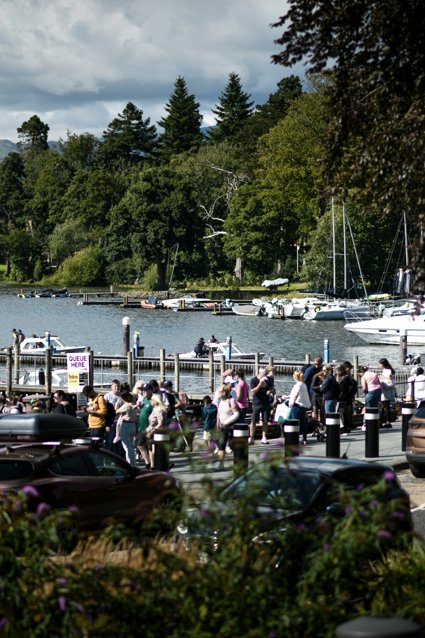
Developing a sense of place in the Lake District
An introduction to the Lake District National Park: Developing a sense of place
Written by PGCE students at the IOE:
-
Claire Harrington
-
Lucy Mitchell
-
Jennifer Pong
-
Victoria Jeeves
-
Emma Camplejohn
The aim of this fieldwork activity is to introduce students to two contrasting areas of the Lake District National Park through a range of ‘sense of place' activities. These activities encourage students to immerse themselves in their surroundings, using all of their senses to consider the characteristics of the area and the physical and human processes that are occurring.
This fieldwork activity is designed for a group of city dwelling students, who may have their own stereotypical view of what rural areas are like. For example, they may think that the Lake District National Park is a homogenous area with similar environmental characteristics throughout. The fieldwork is designed to challenge these views and to extend students' geographical imaginations beyond what may be based on knowledge gained from classroom learning.
Much school fieldwork tends to focus on the collection and interpretation of quantitative data. This activity moves away from this traditional and positivist framework, instead taking a more qualitative and recursive approach.
Although this fieldwork activity can be adapted to take in a range of sites, the examples given here focus on two main locations within the Lake District National Park. The first location is the Great Woods, which is located to the south of Keswick (Grid Reference: 2127 OS map 90). The second location is the town of Bowness (Grid Reference: 4097 OS map 96).
Throughout the fieldwork activity the teacher's role is as facilitator, providing support, explaining activities and pointing out potential risks. The students are encouraged to learn actively and independently. All of the fieldwork resources required for the activity can be found in one resource booklet that covers both sites.
The details of the activities undertaken at the two sites are:
Site one: Great Woods
The teacher will need to lead the students up the path until they have reached a flat surfaced opening with a view overlooking Derwent Water.
Thought Shower
Pupils take a few minutes to take in their surroundings, and write down their initial thoughts about the place, including sights, sounds, smells, feelings and emotions.
Soundscape
Pupils close their eyes and hold up their two fists. Every time they hear a different sound they hold up a finger. Once they think they have heard ten sounds they open their eyes and record them in their fieldwork booklet. Beside each sound they should also write whether it was a natural or man-made sound.
Human Camera
Pupils work in pairs. One person closes their eyes, the other directs them to a place where they ‘take a photo' by opening their eyes and describing what they can see in front of them. They repeat the activity to take a close up ‘photo' and a panoramic one.
Field Sketches
In the fieldwork booklet one half of a field sketch is already completed and the students will have to individually complete the other half. Ensure that students annotate their sketches.
Bi-polar analysis and opinion line
Pupils complete a bi-polar analysis, scoring the site on different variables. Again they record their results in the fieldwork booklet. Once pupils have added up their score for the site, they align themselves in order of their scores. The teacher should then select pupils and ask them to justify their scores/positions. The activity can be repeated with pupils taking on different roles, for example, how would an older or younger person feel about the site.
Interpreting text and photographs
Show students Ingrid Pollard's photos of the Lake District (available from the V&A Museum website or the We English website). Students write captions to accompany each photo, highlighting different features and giving their thoughts about how the photographer and the person in the photographs might be feeling. Next read Ingrid Pollard's own captions for the photographs to the pupils. Pupils reflect on the photos again. Finally, read Wordsworth's poem ‘Daffodils' to pupils (available from the Wordsworth Trust website). Pupils then analyse the poem to see how Wordsworth's views of the Lake District differ to those of Ingrid Pollard. They will need their own copies of the poem to underline key passages. The teacher should facilitate the discussion.
Writing poems
Students should attempt to write their own short poem reflecting on the site and their own feelings about it. For those students who find this activity challenging, ask them to write a short song or a Haiku poem, or allow students to work in pairs.
Final thoughts (Plenary)
Pupils write down three final thoughts about the place and compare these to their initial thoughts. Have their feelings about it changed in any way? Discuss any changes and prompt students for reasons why.
Site two: Bowness
The structure for the activities in Bowness is similar to that carried for the Great Woods. At Bowness the teacher should repeat tasks one to five. However, instead of interpreting texts and photographs and writing poems, the pupils walk around Bowness collecting items and resources that they will use to make a collage about the place when they arrive back at school. Pupils should be collecting things that they think represent Bowness as a place. After this activity the teacher should gather the pupils together for a ‘final thoughts' plenary on Bowness.
Links to the resource booklet, a fieldwork planning sheet and sample risk assessment for the sites used are provided in the grey box to the right of this page. The fieldwork planning sheet relates specifically to a post-16 fieldtrip, during which the activities would be used as an introduction to the topic of ecological conservation. However, the tasks are equally suitable for use with younger age groups from Key Stage 3 upwards.
File nameFiles
File type
Size
Download